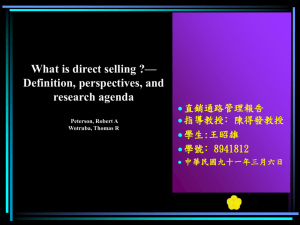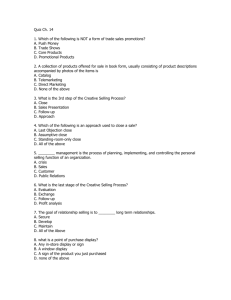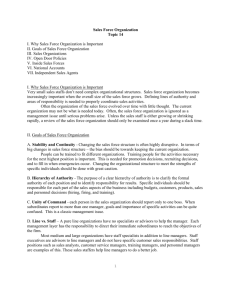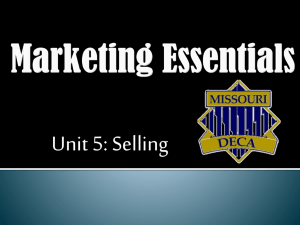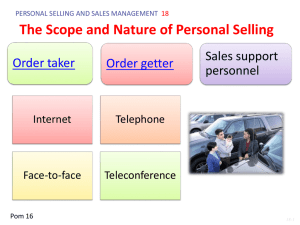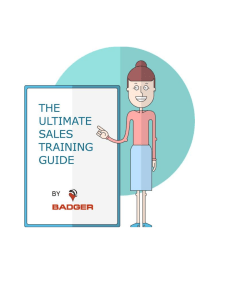Personal selling - Learning Management System
advertisement
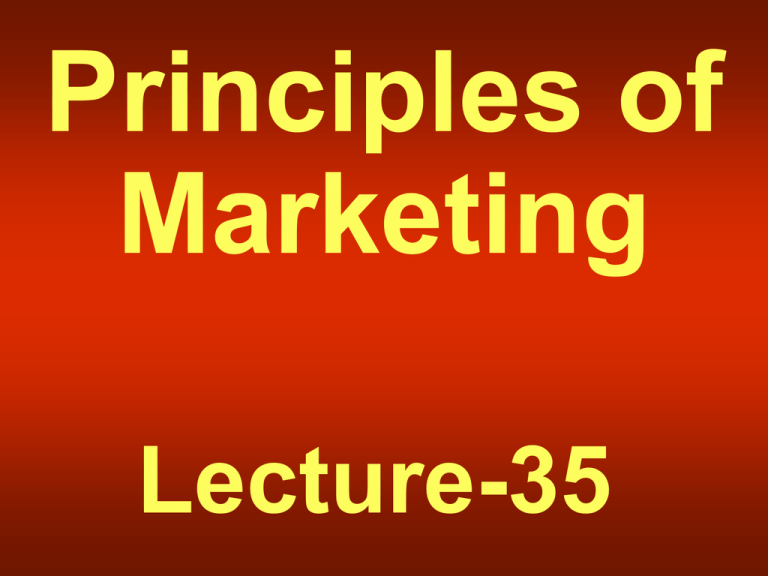
Principles of Marketing Lecture-35 Summary of Lecture-34 Media Scheduling Step 1. Decide on Reach, Frequency, and Impact Step 2. Choosing Among Major Media Types Step 3. Selecting Specific Media Vehicles Step 4. Deciding on Media Timing Evaluating Advertising Effectiveness Advertising Program Evaluation Communication Effects Sales Effects Is the Ad Communicating Well? Is the Ad Increasing Sales? Sales Promotion Major Consumer Sales Promotion Tools Major Trade Sales Promotion Tools Developing the Sales Promotion Program Decide on the Size of the Incentive Set Conditions for Participation Determine How to Promote and Distribute the Promotion Program Determine the Length of the Program Evaluate the Program Today’s Topics Personal Selling Personal selling The direct presentation of a product to a prospective customer by a representative of the selling organization. Personal selling is the personal communication of information to persuade somebody to buy something. Personal Selling occurs when a company representative comes in direct contact with a customer in order to inform a client about a good or service to get a sale. Especially important for businessto-business marketers since products and services are complex and expensive. In many companies, personal selling is the largest single operating expense. Personal selling is likely to be emphasized in a promotional mix when: The market is concentrated. The product has a high unit value, is technical in nature, and requires a demonstration. The product can be tailored to an individual customer’s need. The product is in the introductory stage of the product life cycle. How? Person-to-person dialogue Between prospective buyer and the seller Direct human contact Matching products to needs Involves… developing relationships discovering and communicating customer needs communicating benefits The characteristics of personal selling Flexibility Identify specific sales prospects Adaptation to specific situations Answer questions Overcome objections Builds Relationships Managing the account relationship and assuring the buyers receive appropriate services Salesperson understands and solves buyer’s problems Basic Sales Tasks ?????? ?????? ?????? ?????? ?????? Order-Getting Order-Taking Supporting Order Getting Creative selling More time consuming Sell to new prospects (pioneers) Sell to continuing customers (account managers) Some use of telemarketing, particularly to small accounts Order getting Seek out customers Analyze their problems Discover solutions Sell solutions to customers Order Taking Do very little creative selling Write up orders Check invoices for accuracy Assure timely order processing May use suggestive selling The advantages of personal selling over the other promotion tools… It can be adapted for individual customers. It can be focused on prospective customers. It results in the actual sale, while most other forms of promotion are used in moving the customer closer to the sale. The disadvantages of personal selling Expensive per contact Many sales calls may be needed to generate a single sale Labor intensive It is costly to develop and operate a sales force. It may be difficult to attract high-caliber people. The two types of personal selling The customers come to the salespeople. – Mostly involves retail-store selling. – Most salespeople fall into this category. The salespeople go to the customers. – Usually represent producers or wholesaling middlemen and sell to business users. – Some outside selling is relying more on telemarketing. Customers come to The sales people Inside selling: across-the-counter; phone-in orders Primarily retail store selling Sales force goes to The customers In-person sales calls Inside sales people contact by mail or telemarketing Primarily producers and wholesaling middlemen selling to business users, but also some: Producers Household consumers Retailers Household consumers Business-to-Business Sales Support New Business Existing Business Direct-to-Consumers Retail Sales Direct Selling Representatives Professional Services Characteristics of Professional Selling Sales reps engage in a total selling job. Reps work closely with customers. Sales reps organize much of their own time and effort. They often experience role ambiguity and role conflict. Contributions of Personal Selling to Marketing Producing Sales Revenue Meeting Buyer Expectations Providing Marketplace Information Changing patterns in personal selling Traditionally, personal selling has been a face-to-face, one-on-one situation. Five new patterns are emerging: – Selling Centers — Team Selling – Systems Selling – Global Sales Teams – Relationship Selling – Telemarketing Salesperson Attributes CustomerOriented Likable Competent Honest Dependable Salesperson An individual acting for a company by performing one or more of the following activities: Prospecting, Communicating, Serving, and Information gathering. Salespeople Sales representatives Account executives Sales consultants Sales engineers Agents District managers Marketing representatives Account development reps Etc. Enough for today. . . Summary Personal Selling Personal selling is the personal communication of information to persuade somebody to buy something. Basic Sales Tasks ?????? ?????? ?????? ?????? ?????? Order-Getting Order-Taking Supporting The two types of personal selling The customers come to the salespeople. – Mostly involves retail-store selling. – Most salespeople fall into this category. The salespeople go to the customers. – Usually represent producers or wholesaling middlemen and sell to business users. – Some outside selling is relying more on telemarketing. Next…. Sales Force Management Principles of Marketing Lecture-35


